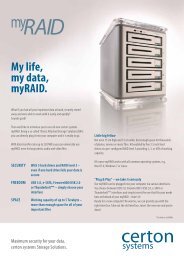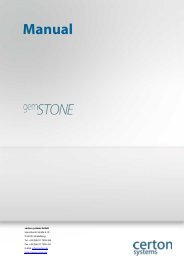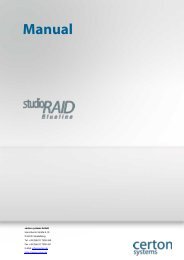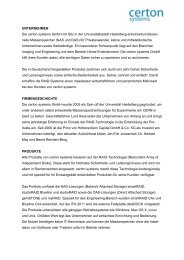You also want an ePaper? Increase the reach of your titles
YUMPU automatically turns print PDFs into web optimized ePapers that Google loves.
www.<strong>certon</strong>.de<br />
the cost. Two hard disks may fail without any data loss occurring.<br />
• Select Volume Capacity ": Here you can enter the desired volume size in gigabytes.<br />
• Greater Two TB Volume Support: Enable this feature if you use a 64bit operating system. Only<br />
64bit operating <strong>systems</strong> support partitions larger than 2 terabytes.<br />
• "Volume Initialization Mode". Using this function you can control the initialization of the<br />
volume. "Foreground Initialization" means that the volume is only available when it is fully<br />
initialized. This is the fastest. "Background Initialization" means that the initialization occurs in<br />
the background, but the volume is readily available and can be used after a format. However, it<br />
is initially a bit slower because the initialization is running in the background. If the option is not<br />
selectable, you have a RAID level selected, that does not require initialization (such as RAID level<br />
0).<br />
• Using the "Volume Size Stripe" They affect the critical speed of the Gemstone. If you are mostly<br />
small files, so you should choose a small stripe size. Do you work primarily with large files, so<br />
choose a large StripeSize.<br />
• "Volume Cache Mode": Here you can choose between "Write Back" and "Write Through". "Write<br />
Through" turns off the built-in cache of the system and thus slows down the rate appreciably.<br />
"Writeback" uses the gemSTONE’s built in cache.<br />
• Using the "SATA Data Xfer Mode 'you can choose the right protocols for accessing the built-in<br />
hard drives:<br />
o SATA150 should be chosen for older drives though after the SATA I standards were<br />
introduced.<br />
o SATA150 + NCQ should be chosen for older drives (SATA I standard) and utilise Native<br />
Command Queuing. Look at the documentation of the hard drives.<br />
o SATA300 should be chosen for drives that are more modern and to the SATA II standard.<br />
o SATA300 + NCQ should be chosen for drives that are more modern and to the SATA II<br />
standard and utilize Native Command Queuing. Look at the documentation of the hard<br />
drives.<br />
If you have purchased the gemSTONE complete with hard disks please select SATA300 + NCQ.<br />
i<br />
• Channel: Drv #. This association between the channel and allows the assignment of drive letters<br />
that you create volumes on the desired interface.<br />
o SATA (CH0)<br />
Port 0 to 7 : Under this setting, you can reach the volume via the eSATA interface.<br />
Port 8 to 15: Under this setting, you can reach the volume via the USB 3.0 or FireWire 800<br />
port. To choose between these two interfaces you have the right under "System<br />
Controls" -> select "System Config" in the column "USB 3.0 / 1394 Select" the appropriate<br />
interface.<br />
o USBiA (CH1)<br />
To enable USB 2.0 for this volume select one of the ports between 0 and 7. The first<br />
volume, that is to communicate via USB 2.0, must have the port number 0. The second<br />
volume is the port 1 and so on.<br />
To enable iSCSI select a port 8 to 15.<br />
Seite 22













